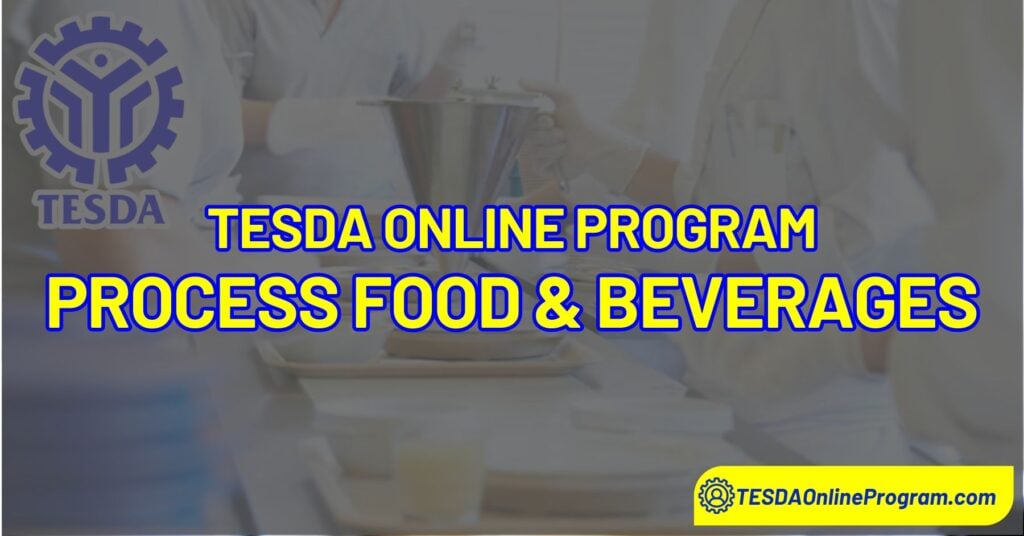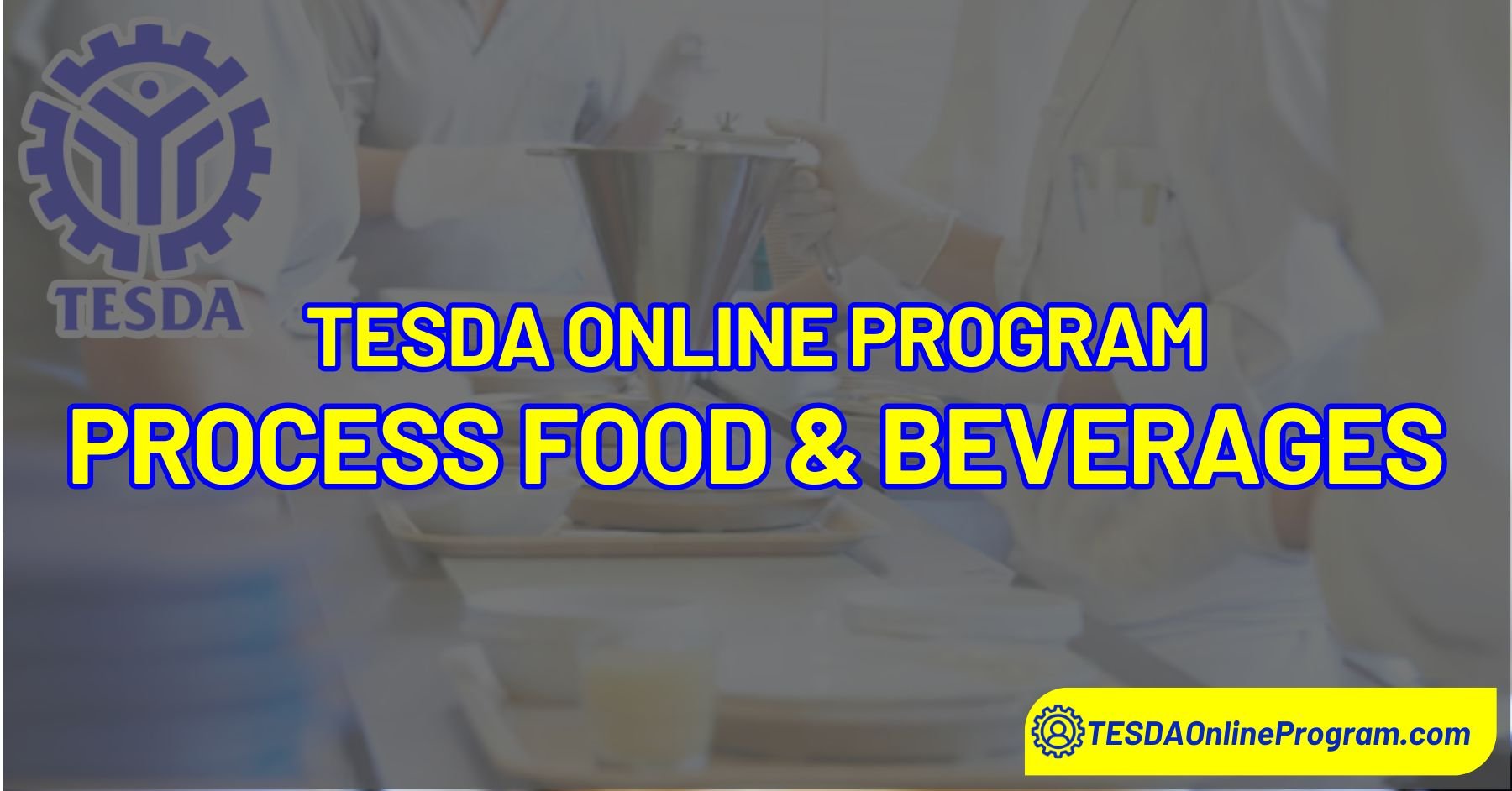The Food Processing NC II course under TESDA Online Program (TOP) provides a comprehensive training platform for individuals looking to gain expertise in food processing methods. This online course is designed to develop essential skills and knowledge in preparing and preserving food through techniques such as fermentation, pickling, sugar concentration, drying, and dehydration. It is an excellent opportunity for aspiring food processors to learn at their own pace and convenience.
Also read: TESDA Food and Beverage Services Courses
With its accessible and well-structured curriculum, the Food Processing NC II course aims to equip learners with practical competencies that meet industry standards. Whether you’re pursuing a career in food processing or looking to enhance your existing skills, this TESDA program ensures you gain the required know-how to excel in the field of food and beverage processing.

Food Processing NC II
The Food Processing NC II online course by TESDA Online Program offers a detailed and extensive curriculum designed to cover a wide array of competencies. This program equips individuals with the skills to process foods through various methods including fermentation, pickling, sugar concentration, drying, and dehydration.
Modules
There are a total of 6 modules in the TESDA Food Processing NC II Online Course, each covering a specific set of competencies and skills essential for food processing.
Module 1: Introduction to Food Processing
This module offers an overview of the food processing industry, covering career opportunities, responsibilities, and expectations. Participants will learn fundamental principles, essential skills, and core competencies. Designed as a self-paced course, it includes accessibility features for hearing and visual impairments.

UNIT 1: The Food Processing Industry
- Lesson 1: The Food Processing Industry Personnel
- Lesson 2: The Food Processing Plant
UNIT 2: Fundamentals of Food Processing
- Lesson 1: Principles of Food Processing
- Lesson 2: Food Safety and Sanitation
- Lesson 3: Food Manufacturing Practices
Lesson 4: Dietary Laws
By the end of this unit, you’ll be able to:
- Cite methods of food processing
- Explain how food spoilage occurs
- Demonstrate food safety and sanitation practices
- Perform occupational safety procedures
- Practice good housekeeping and proper waste disposal
- Explain the process of cleaning and sanitizing equipment, tools, and utensils
- Identify dietary laws in food processing
UNIT 3: Basics of Food Processing
- Lesson 1: Basic Skills in Preparing Raw Materials
- Lesson 2: Standard Measurements and Conversions
- Lesson 3: Quality Control Parameters
- Lesson 4: Production Report and Costing
By the end of this unit, you’ll be able to:
- Demonstrate basic skills in preparing raw materials
- Convert kitchen measurements
- Measure quality control parameters using the right apparatus
- Make the production report and costing
Module 2: Processing Food by Drying and Dehydration
The module covers essential knowledge and skills for drying and dehydrating food for preservation. It includes techniques for processing, packaging, and storing dried and dehydrated products. This self-paced course also features accessibility options for learners with hearing and visual impairments.

UNIT 1: Drying and Dehydration
- Lesson 1: Preparing Raw Materials
- Lesson 2: Processing Food by Drying and Dehydration
- Lesson 3: Dried Products
By the end of this unit, you’ll be able to:
- Prepare raw materials for processing food by drying and dehydration
- Cite different techniques for drying
- Process food by drying and dehydration
UNIT 2: Packaging and Storing Dried and Dehydrated Products
- Lesson 1: Storage Facilities for Dried and Dehydrated Products
- Lesson 2: Packaging Materials and Equipment for Dried and Dehydrated Products
- Lesson 3: Packaging Dried and Dehydrated Products
- Lesson 4: Labelling
By the end of this unit, you’ll be able to:
- Determine the type of storage for dried and dehydrated products
- Identify packaging materials and equipment for dried and dehydrated products
- Demonstrate techniques in packaging dried and dehydrated products
- Illustrate a proper label for dried and dehydrated products
Module 3: Processing Food by Sugar Concentration
This module teaches essential skills for processing food through sugar concentration, including making jellies, jams, marmalades, and preserves. You’ll also learn proper packaging and storage techniques. The self-paced course includes accessibility features for learners with hearing and visual impairments.

UNIT 1: Sugar Concentration
- Lesson 1: Instruments/Apparatus Used in Sugar Concentration
- Lesson 2: Preparing Raw Materials
- Lesson 3: Sugar-Concentrated Products
- Lesson 4: Common Tests for Sugar – Concentrated Products
By the end of this unit, you’ll be able to:
- Identify instruments/apparatus used in sugar concentration
- Learn the basic skills in preparing raw materials for sugar concentration
- Process raw materials by sugar concentration
- Perform common tests for sugar-concentrated products
UNIT 2: Packaging and Storing Sugar-Concentrated Products
- Lesson 1: Packaging Materials
- Lesson 2: Packaging Process
- Lesson 3: Storage
By the end of this unit, you’ll be able to:
- Identify packaging materials and equipment for sugar-concentrated products
- Demonstrate the packaging process for sugar-concentrated products
- Determine the type of storage to extend the shelf-life of sugar-concentrated products
Module 4: Processing Food by Fermentation and Pickling
This module teaches the skills for fermenting and pickling food. Readers will learn to make wines, vinegars, yogurts, and pickles at home. The course also covers proper packaging and storage techniques.

UNIT 1: Fermentation
- Lesson 1: Preparing Raw Materials
- Lesson 2: Processing Food by Fermentation
By the end of this unit, you’ll be able to:
- Identify quality points for fruit, vegetables, and fish
- Prepare raw materials for fermenting and pickling
- Perform three kinds of fermentation
UNIT 2: Pickling
- Lesson 1: Processing Food by Pickling
By the end of this unit, you’ll be able to:
- Prepare basic pickling solutions
- Perform pickling
UNIT 3: Packaging and Storing Fermented and Pickled Products
- Lesson 1: Packaging Materials
- Lesson 2: Packaging Process
- Lesson 3: Storage
By the end of this unit, you’ll be able to:
- Identify packaging materials and equipment for fermented and pickled products
- Demonstrate the packaging process for fermented and pickled products
- Determine the type of storage to extend shelf-life of fermented and pickled products
Module 5: Processing Food by Thermal Application
This module teaches essential skills for thermal food processing, including equipment preparation, pasteurization, and pressurization techniques. It also covers guidelines for packaging and storing processed products effectively.

UNIT 1: Preparing Equipment and Apparatus for Thermal Application
- Lesson 1: Equipment
- Lesson 2: Apparatus
By the end of this unit, you’ll be able to:
- Identify equipment and apparatus used in thermal application
- Use the following equipment and apparatus in processing food by thermal application
UNIT 2: Processing Food by Pasteurization
- Lesson 1: Methods of Pasteurization
- Lesson 2: Products of Pasteurization
By the end of this unit, you’ll be able to:
- Identify the two methods of pasteurization
- Process food by pasteurization
UNIT 3: Processing Food by Pressurization
- Lesson 1: Processing Foods by Pressurization
- Lesson 2: Products of Pressurization
By the end of this unit, you’ll be able to:
- Explain the steps in pressure canning
- Process food by pressure canning
UNIT 4: Packaging and Storing Pasteurized and Pressurized Products
- Lesson 1: Packaging Materials and Equipment for Pasteurized and Pressurized Products
- Lesson 2: Labelling
- Lesson 3: Storage
By the end of this unit, you’ll be able to:
- Identify packaging materials and equipment for pasteurized and pressurized products
- Demonstrate the packaging process for pasteurized and pressurized products
- Determine the type of storage to extend shelf-life of pasteurized and pressurized products
Module 6: Processing Food by Salting, Curing, and Smoking
This module addresses the knowledge and skills necessary for processing food through salting, curing, and smoking. It will delve into the underlying concepts behind these methods. Participants will also learn the proper techniques for packaging and storing salted, cured, and smoked products.

UNIT 1: Salting, Curing, and Smoking
- Lesson 1: Salting
- Lesson 2: Curing
- Lesson 3: Smoking
By the end of this unit, you’ll be able to:
- Explain the preservative properties of salt;
- Identify raw materials needed for salting, curing, and smoking;
- Prepare brining and curing solutions; and
- Perform salting, curing, and smoking.
UNIT 2: Packaging and Storing Salted, Cured, and Smoked Products
- Lesson 1: Packaging Materials and Equipment for Salted, Cured, and Smoked Products
- Lesson 2: Packaging and Labelling Salted, Cured, and Smoked Products
- Lesson 3: Storage Facilities for Salted, Cured, and Smoked Products
By the end of this unit, you’ll be able to:
- Determine the type of storage for salted, cured, and smoked products;
- Identify packaging materials and equipment for salted, cured, and smoked products.
- Demonstrate techniques in packaging salted, cured, and smoked products.
- Illustrate a proper label for salted, cured, and smoked products.
These modules offer a comprehensive overview of food processing methods. By course end, participants will gain skills in preparing, processing, packaging, and storing food. The self-paced course includes accessibility features for learners with hearing and visual impairments.
Also read: TESDA Food Production (Professional Cookery) Courses
Summary
The Process Food and Beverages Online Course, offered through the TESDA Online Program, provides a comprehensive learning opportunity for individuals aspiring to join the food processing industry. The course covers key areas, including proper food handling, preparation, packaging, and storage techniques. Additionally, it features accessibility options to support learners with disabilities. By enrolling in this program, participants can acquire valuable skills and knowledge to kickstart a career in food processing or enhance their existing expertise for improved job prospects.

